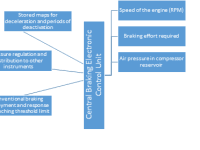INTRODUCTION
This project aims at providing a new method of Regenerative Braking, by deactivating fuel supply and ignition during periods of braking and providing a valve to divert the outlet air from the cylinder to a storage tank, acting as a reciprocating compressor. Energy is spent in compressing the air and hence, slows down the vehicle, along with the production of compressed air.
STORED MAPS FOR THE IDLE PERIODS
The deactivation period is calculated based on the stored maps according the level of braking desired. The electronic system also ensures the direct use of brake pads when the extent of braking required is high.
REQUIRED MODIFICATIONS IN THE ENGINE LAYOUT
Only the outlet manifold is to be modified to provide an alternate path for air flow during periods of braking, which also involves an inherent non-return valve in the compressor. It is important to note that the level of braking achieved significantly varies with the pressure of gas(air) in the reservoir which opposes the piston movement. Hence, it is mandatory to regulate the pressure to allow it to operate within a specific range of pressures. The reservoir is the only major additional requirement. The size of it can be optimised to satisfactorily achieve the braking effect and also the associated subsequent applications. The pressure can be released in the case of the pressure generation being higher than the desired limit with the help of suitable electronic circuits operating the release valves.
INCLUSION OF A THRESHOLD ROTATION SPEED OF THE ENGINE
It is also important that the vehicle doesn't stall because of the deactivation of the power and hence, the electronics should also ensure normal engine operation once the RPM of the engine reaches a threshold value and to use conventional braking during that period.
APPLICATIONS OF THE ADDITIONAL SYSTEM
The compressed air can be used for purposes like:
• Air braking (much useful in case of heavy vehicles)
• Pilot operated door opening and retraction system
• Additional mini compressed air engine for functions like battery charger
ADVANTAGES OF THE ADDITIONAL SYSTEM
• Lesser wear and tear of brake pads
• Air operated system operations without any additional battery capacity requirement
• Reduction in the fuel consumption because of non-requirement of cam-shaft-coupled battery charges and
brake pressure compressors and also the deactivation of supply during braking
INCORPORATING THE COMPRESSOR OUTPUT INTO THE BRAKING SYSTEM
Since electronic circuits are to used to engage direct conventional braking in case of requirement of higher deceleration or engine speed falling below the threshold value and also to comply with the requirements like ABS, the air pressure can be used to engage the conventional brakes. Hence, that allows higher braking rates and also with heavy loads as in trucks, when power-braking is indispensable.
CONCLUSION
It is seen that with the incorporation of some minor changes in the design, there are potential benefits in the form of more efficient braking, which also serves other complimentary benefits which would otherwise require separate power source for their working.
Like this entry?
-
About the Entrant
- Name:Praveen S
- Type of entry:individual
- Patent status:none





